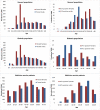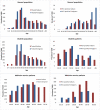Hepatitis C virus cascade of care in the general population, in people with diabetes, and in substance use disorder patients
- PMID: 33468188
- PMCID: PMC7816419
- DOI: 10.1186/s13027-021-00345-8
Hepatitis C virus cascade of care in the general population, in people with diabetes, and in substance use disorder patients
Abstract
Background: The aim was to evaluate the hepatitis C virus (HCV) cascade of care in the general population (GP) and in two high-risk populations: patients with diabetes mellitus (DM) and substance users (AS) in treatment in Reggio Emilia Province, Italy.
Methods: A population-based cross-sectional study was conducted that included 534,476 residents of the Reggio Emilia Province, of whom 32,800 were DM patients and 2726 AS patients. Age-adjusted prevalence was calculated using the direct method of adjustment based on the age-specific structure of EU population.
Results: The prevalence of HCV testing was 11.5%, 13.8%, and 47.8% in GP, DM, and AS patients respectively, while HCV prevalence was 6.5/1000, 12.6/1000, and 167/1000, respectively. The prevalence of HCV RNA positivity was 4.4/1000, 8.7/1000, and 114/1000 in the three populations, respectively. The rates of HCV RNA-positive individuals not linked to care were 27.9%, 27.3%, and 26% in GP, DM, and AS patients, respectively, while the rates of those cured or cleared were 70.9%, 71%, and 69.9%, respectively. The prevalence of HCV testing was higher for females of reproductive age than for males the same age: 218.4/1000 vs. 74.0/1000, respectively. While more foreigners than Italians underwent the HCV test and were HCV positive, fewer foreigners than Italians received HCV treatment and were cured.
Conclusions: The low HCV testing and linkage to care rates remain an important gap in the HCV cascade of care in Northern Italy. The prevalence of cured/cleared residents remains lower among foreigners than among Italians.
Keywords: Addiction; Cascade of care; Diabetes mellitus; Hepatitis C virus; Hepatocellular carcinoma; Linkage to care.
Conflict of interest statement
The authors declare that they have no competing interests.
Figures





References
-
- Blach S, Zeuzem S, Manns M, Altraif I, Duberg AS, Muljono DH, et al. Polaris observatory HCV collaborators. Global prevalence and genotype distribution of hepatitis C virus infection in 2015: a modelling study. Lancet Gastroenterol Hepatol. 2017;2:161–176. doi: 10.1016/S2468-1253(16)30181-9. - DOI - PubMed
-
- European Centre for Disease Prevention and Control . Hepatitis B and C epidemiology in selected population groups in the EU/EEA. Stockholm: ECDC; 2018.
-
- World Health Organization. Global Health Sector Strategies on Viral Hepatitis 2016–2021. Available from: http://apps.who.int/gb/ebwha/pdf_files/WHA69/A69_32-en.pdf?ua=1. (Accessed 30 Aug 2020).
-
- National Hepatitis Plan. Piano nazionale per la prevenzione delle epatiti virali da virus B e C (PNEV). Available at: http://www.salute.gov.it/imgs/C_17_pubblicazioni_2437_allegato.pdf (Accessed 30 Aug 2019).
LinkOut - more resources
Full Text Sources
Other Literature Sources
Research Materials
Miscellaneous

